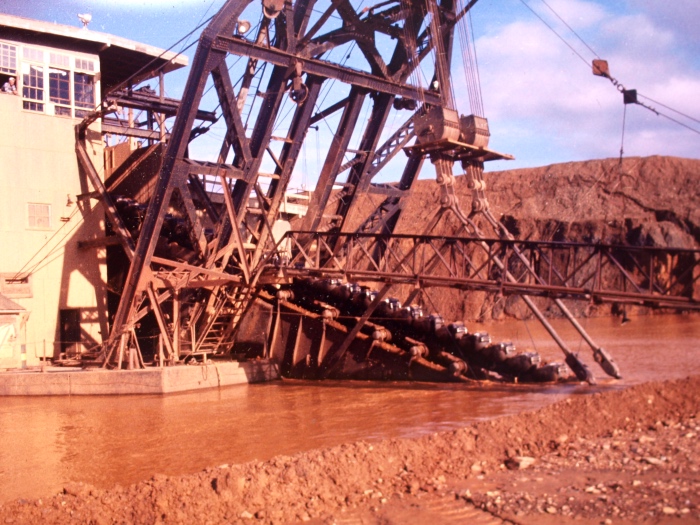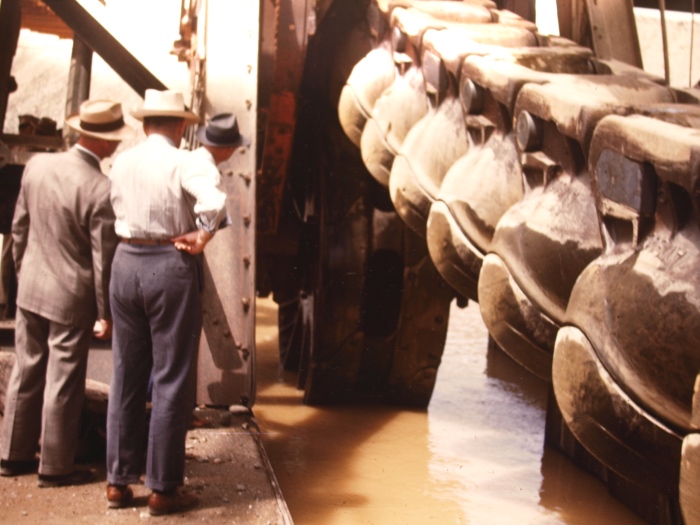
The first miners to come to the goldfields didn’t have much besides a pick and a pan. During the early days of the gold rush, it was hard, backbreaking manual labor that was needed if a miner wanted to find gold.
As the years progressed, new inventions were made that made the extraction of gold much easier and certainly more efficient.
One of the transformative pieces of equipment that increased gold recovery was something called a bucket line dredge. Below are more details about this wonderful equipment, and its relationship to gold mining. The first one was designed in New Zealand, and soon they were being used in the goldfields of the U.S. The amount of gold that they recovered was staggering.
The Design of the Bucket Line Dredge
The bucket line dredges are huge gold mining machines that have been specifically designed to move tons of material within the shortest possible time. The machines were not operated automatically. Instead, they were manually fixed in a given position using the parts known as winches.
The design of a bucket line dredge is very simple. Its front consists of a number of metallic buckets known as the boom, which are specifically designed to rotate in a continuous loop similar to a big chainsaw. When the machine is running, the buckets, also known as the boom are positioned downwards into the earth where they scoop and dig up a continuous supply of gravels to be processed for extraction of the mineral.
The bucket line dredge has an endless looped chain of buckets which are carried on rollers that are mounted on a steel ladder, in which the upper part of the ladder is fixed on a gantry frame above the deck of the dredge.
When using the machine, the lower end of the ladder is suspended by the cables which pass over the sheaves to a drum on a winch, and this enables the operator to adjust the ladder upwards or downwards respectively in order to deposit something in the buckets.
The lower and the upper ends of the ladder on the dredge are fixed with the tumblers; subsequently power to operate the machine is applied to the upper tumbler using the gears.

Processing the Gravel
The materials that are excavated by the buckets are dumped into a hopper. Then from the hopper material is fed into the revolving or shaking screen. The water subjected to high pressure is forced from the spray pipes over the screen on to the gravel, washing away clays and releasing the gold.
The material suspected to have gold is allowed to be screened into the distributor, which later transports it to the tables that are provided with riffles. From the tables, the material flows into the side or tail sluices which deposit the unwanted content behind the dredge using the conveyors.
The process of separating gold from gravel is very much similar to any sort of gravity separation method. The heavy particles of gold are put in suspension of water, letting the heavy gold particles to drop down into the riffles while the lighter material is run through and discarded.

Men working inside of the trommel. This is where the large rocks and gravel were separated from the smaller sands and gravels that contained the gold.
Moving the Dredge
The machines were locked in a desired place or position using a spud. When it was set in any given position, the whole of it was designed to make movements around the place of operation to have access to material in front of it. Upon depleting the material available, the dredge would be moved further and mounted where suitable material was found.
The dredge floats in the pond that it makes for itself. When it digs out the material in front of itself, it can then be moved forward incrementally, where it can reach new gravels for digging. This process was repeated for miles and miles. The dredge would zigzag across the valley floor.

Men inspecting a bucket line dredge in Good News Bay, Alaska. Although most dredges were designed to recover gold, they were also used for platinum mining such as this one.
Dredges Sit Idle
The bucket line dredges primarily started their operations from the start of the 20th century, with the height of their use occurring in a time span from the 1930s through the 1950s. There are still some bucket line dredges in operations, but most of the machines today are out of service as they are not operational anymore.
The problem with these huge dredges was their impact on the environment. Since they are used to mine placer gold deposits in river bottoms, they essentially tear up the riparian area. Silts and fine material are lost downstream, and only rocks and gravel are left behind. This has a very negative impact on fish habitat and other riparian resources.
There are still dredges being used today in some countries, but nearly all of the dredges that once operated in the United States have long ago been abandoned. They were responsible for some amazing gold recoveries, and were used throughout most of the placer mining districts during the mid 20th century.
Next: Explore Historic Mining Sites to Find Gold
Also Read: Can You Actually Make Money Mining for Gold?
And: Crush & Melt! How to Recover Gold from Rich Ores
